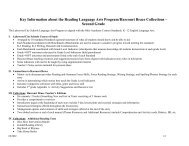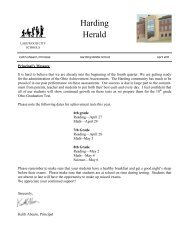Ohio Revised Science Standards and Model Curriculum High School
Ohio Revised Science Standards and Model Curriculum High School
Ohio Revised Science Standards and Model Curriculum High School
You also want an ePaper? Increase the reach of your titles
YUMPU automatically turns print PDFs into web optimized ePapers that Google loves.
Course Content<br />
The following information may be taught in any order; there is no ODE-recommended sequence.<br />
Interactions of Matter<br />
• Chemical reactions<br />
o Types of reactions<br />
o Kinetics<br />
o Energy<br />
o Equilibrium<br />
o Acids/bases<br />
• Gas laws<br />
o Pressure, volume <strong>and</strong> temperature<br />
o Ideal gas law<br />
• Stoichiometry<br />
o Molar calculations<br />
o Solutions<br />
o Limiting reagents<br />
• Nuclear Reactions<br />
o Radioisotopes<br />
o Nuclear energy<br />
Content Elaboration<br />
Interactions of Matter<br />
• Chemical Reactions<br />
In the physical science syllabus, coefficients were introduced to balance simple equations. Other<br />
representations including Lewis structures <strong>and</strong> three-dimensional models also were used <strong>and</strong><br />
manipulated to demonstrate the conservation of matter in chemical reactions. In this course, more<br />
complex reactions will be studied, classified <strong>and</strong> represented with chemical equations <strong>and</strong> three-<br />
dimensional models. Classifying reactions into types can be a helpful organizational tool in<br />
recognizing patterns of what may happen when two substances are mixed (see Note). Some<br />
general types of chemical reactions are oxidation/reduction, synthesis, decomposition, single-<br />
replacement, double replacement (including precipitation reactions <strong>and</strong> some acid-base<br />
neutralizations) <strong>and</strong> combustion reactions. Some reactions can fit into more than one category. For<br />
example, a single replacement reaction also can be classified as an oxidation/reduction reaction.<br />
Identification of reactions involving oxidation <strong>and</strong> reduction as well as indicating what substance is<br />
being oxidized <strong>and</strong> what is being reduced are appropriate in this course. However, balancing<br />
complex oxidation/reduction reactions will be reserved for more advanced study.<br />
Organic molecules release energy when undergoing combustion reactions <strong>and</strong> are used to meet the<br />
energy needs of society (e.g., oil, gasoline, natural gas) <strong>and</strong> to provide the energy needs of<br />
biological organisms (e.g., cellular respiration). When a reaction between two ionic compounds in<br />
aqueous solution results in the formation of a precipitate or molecular compound, the reaction often<br />
occurs because the new ionic or covalent bonds are stronger than the original ion-dipole<br />
interactions of the ions in solution. Laboratory experiences (3-D or virtual) with different types of<br />
chemical reactions must be provided.<br />
Note: Teachers should be aware that the common reaction classifications that are often used in<br />
high school chemistry courses often lead to misconceptions because they are not based<br />
on the actual chemistry, but on surface features that may be similar from one system to<br />
another (e.g., exchanging partners), even though the underlying chemistry is not the<br />
same. However, they may be useful in making predictions about what may happen when<br />
two substances are mixed.<br />
Back to the INDEX<br />
<strong>Ohio</strong> Department of Education, March 2011 Page 20 of 94
















